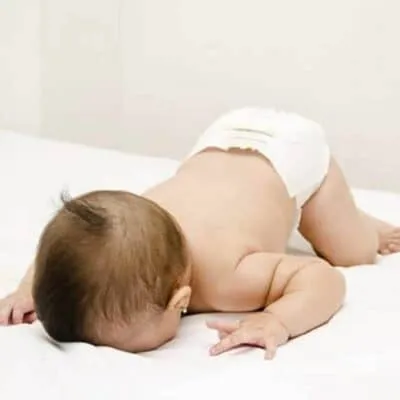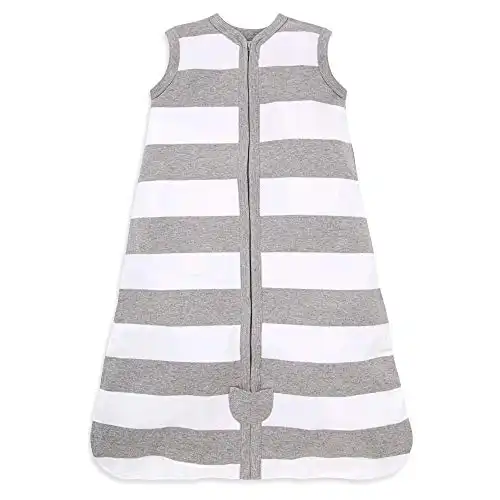Is Your Baby Sleeping Face Down? Why Baby’s Back is Best!
Safe Sleeping for Babies
As a parent, few things are more important than your baby getting healthy, restful sleep. You likely cherish watching your little bundle of joy snoozing peacefully. While a baby sleeping face down on a mattress may seem natural, this sleeping position can significantly increase the risk of SIDS (Sudden Infant Death Syndrome).
By understanding SIDS risks and following doctor-recommended sleeping practices, you can help lower the chances of SIDS and ensure your baby sleeps soundly through the night. In this post, we’ll cover safe sleeping tips for your baby.
This post may contain affiliate links. For my full disclosure policy click here.
For newborns, swaddling in a cot or bassinet is a great start for a secure sleeping environment. However, as your baby grows older and becomes more active, traditional blankets and bedding can be risky.
When our baby was old enough to roll over on their own, we transitioned them to a sleep sack. This acts as their blanket and keeps the cozy but greatly reduces the risk of them becoming tangled with the help of zippers.
By ensuring your baby’s sleeping space is free of blankets, pillows, and bumpers, you can greatly reduce the risk of SIDS. Also, ensure the mattress fits snugly and avoid covering your baby’s face or head. Putting your baby to sleep on their back and avoiding smoking around them can also decrease risks.
For added peace of mind, consider investing in a baby monitor with a sensor pad. This will alert you if your baby hasn’t moved in a specified amount of time.
With the right precautions and equipment, you can provide a safe and comfortable sleeping environment for your little one.
Baby Sleeping Face Down On Mattress

But my Baby is Calm When Sleeping Face Down?
We know it can be tough stuff to keep your newborn comfortable and safe during sleep time. That’s why we want to remind you that it’s never safe to let your baby sleep directly on their face due to the risk of asphyxia. This is one of the main causes of Sudden Infant Death Syndrom (SIDS)
While it’s true that some babies might feel more at ease sleeping on their stomachs, it’s not worth the risk. We understand that some parents might be tempted to try this method out of desperation, but please resist the urge and keep your baby safe!
Remember: safety always comes first, even when you’re exhausted and just want your baby to finally go to sleep!

You can take precautions such as the baby monitors mentioned above or placing your newborn in a sleep sack or swaddle to keep them from squirming over onto their belly.
When Can Babies Sleep on Their Stomachs
The American Academy of Pediatrics recommends that babies sleep on their backs until they’re one year old. This goes for naps too! After that, it’s safe for them to sleep on their stomachs with minimal risk.
Experts don’t fully understand why the risk of Sudden Infant Death Syndrome (SIDS) decreases after one year, but research shows that it does.
Keep in mind that if your little one rolls from back to tummy and tummy to back, there’s no need to flip them onto their back in the middle of the night. They can safely sleep face down or on their stomach, and if they need to, they can turn themselves over.
How to Handle a Baby Who Rolls onto Their Stomach While Sleeping
Infants get more mobile as they get older. Between the ages of 4 and 6 months, mothers or caregivers may observe a baby beginning to roll from its back to its stomach. Caregivers do not need to change the infant’s posture if the baby rolls onto their stomach while sleeping as long as they are able to roll back over.
Every night, simply start with the baby sleeping on their back in a safe sleeping space, free of blankets and pillows. Sit back and watch the dance party as wiggle and roll around their crib throughout the night! You’ll often find your baby face down on the mattress and sprawled diagonally across the crib when you go into their room in the morning.
Breathable Crib Mattress
If your baby must absolutely sleep face down on a mattress there is a potential solution. Surprisingly, a completely air permeable mattress has been created. One of the top pediatricians recommended a breath-through mattress. Specifically, when sleeping face down, a newborn can breathe normally. It is known as the Breath-Through Crib Mattress.
Tests on its innovative design demonstrate that breathing through the mattress results in 100% oxygen-rich air. This function is absent from most crib mattresses on the market.
It is one of the most popular crib mattresses recommended by pediatricians. In fact, it is the only crib mattress for newborns who require stomach sleep due to health concerns that pediatricians and respiratory therapists prescribe.
Why do babies sleep with their butt in the air
Babies’ Ideal Sleeping Position
Back is best! Especially for those between birth and roughly four months of age, once they are able to roll on their own.
Sudden infant death syndrome (SIDS), which is responsible for many newborn deaths in the first year of life. It is now taught that lying on one’s back is a safer position. Even if your baby spits up! They will be able to clear this much easier than they can push a sheet out of their mouth.
Some babies may need to sleep on their stomachs due to specific situations or health concerns. In these situations, it is crucial to bring up these worries with your pediatrician.
Sudden Infant Death Syndrome (SIDS)
Sudden Infant Death Syndrome, or SIDS, has alarmed parents worldwide. This prompted medical professionals to carefully examine infants’ sleeping patterns. The ideal sleeping posture for infants has long been thought to be on their stomachs. Actually, this is not the case.
Modern research has confirmed that a baby sleeping face down may have some negative health effects. The infant’s mouth and nose, which are essential for healthy breathing, are obstructed when babies sleep face down on a mattress.
Back sleeping is strongly advised by the American Academy of Pediatrics (AAP). According to recent studies, when parents are instructed to switch their baby’s sleeping position from stomach to back or side. The likelihood of SIDs is reduced by about 60%.
When a newborn sleep on his stomach, he may be suffocated. Because their neck muscles are weak, some newborns may suffocate if they turn their heads. The best option is to sleep on their backs. It’s crucial that they keep their faces up and not crouch.
Babies may experience some slight discomfort if they sleep on their backs. They might experience some uncontrollable reflexes while they sleep, which could trigger them and lead them to wake up in the middle of the night. You can swaddle them with a blanket to avoid this. Just be careful to properly wrap them.
A healthy sleeping position will guarantee your infant a restful night and reduce the risk of SID. Additionally, proper bedding may encourage restful sleep. Avoid putting cuddly animals in your baby’s resting space and pick a firm mattress. Toys and other unnecessary items in their bed are dangerous.
At night, when babies are more likely to move. These objects may come in contact with their faces and obstruct their airways.
It might not always be possible to keep an eye on your baby while he sleeps. Because of this, it’s crucial to make sure his bed is secure enough for them to sleep in.
Maintaining your child in the appropriate sleeping postures will not only help them get a good night’s sleep but will also help keep them healthy.
Why should babies sleep on their back
Conclusion
We can all play our part in helping to protect babies from the risk of SIDS. Each night, as you lay your baby down to sleep, be sure that they are on their back. This small act can make a big difference! Not only will it help reduce the possibility of SIDS but it could also potentially save a life. Parents have a unique and special responsibility when it comes to looking after their babies and by taking steps such as helping them sleep safely on their back you’re giving them the best chance at surviving and thriving in life. Remember, when it comes to your baby’s safety, there is no greater gift than taking precautions and staying informed. So spread awareness, keep learning, and most importantly—watch over your little one with love.
Can babies sleep face down on a mattress?
Yes and no. Once your baby is able to roll themselves from belly to back and back to belly the risk for them asphyxiating goes down significantly. Until then, they should only be placed to sleep on their back.
Why does my baby bury their face in the mattress?
These types of sensory-seeking behaviors might be a comfort mechanism, a way to self-soothe when babies are feeling out of sorts, hungry, tired, or just overwhelmed.
Why does sleeping face down increase SIDS
Stomach sleeping can increase “rebreathing” — when babies breathe in their own exhaled air — particularly if the baby is sleeping on a soft mattress or with bedding, stuffed toys, or a pillow near their face. As the baby rebreathes exhaled air, the oxygen level in the body drops and the level of carbon dioxide rises.



